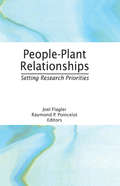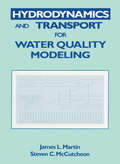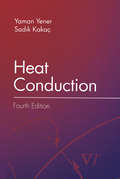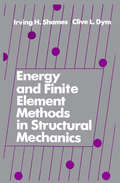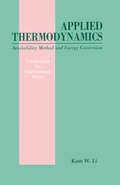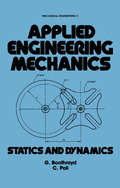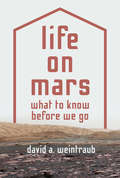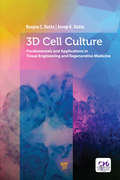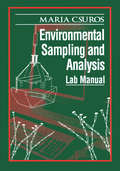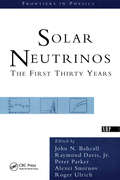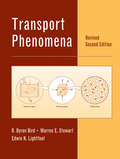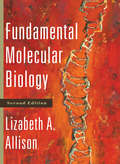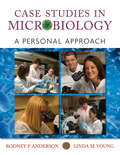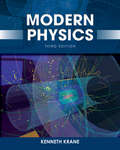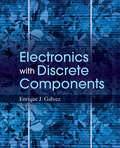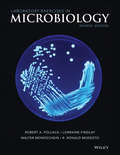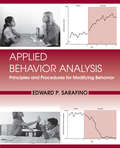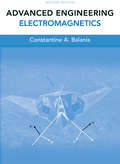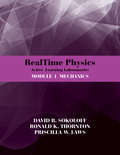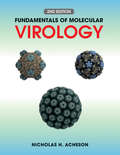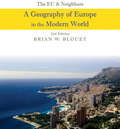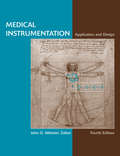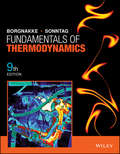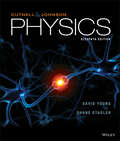- Table View
- List View
People-Plant Relationships: Setting Research Priorities
by Raymond P Poincelot Joel FlaglerPresenting the latest research on cross-cultural people-plant relationships, this volume conveys the psychological, physiological, and social responses to plants and the significant role these responses play in improved physical and mental health. With chapters written by field experts, it identifies research priorities and methodologies and outlines the steps for developing a research agenda to aid horticulturalists in their work with social scientists to gain a better understanding of people-plant relationships. This resource covers a wide array of topics including home horticulture and Lyme disease, indoor plants and pollution reduction, and plants and therapy.
Hydrodynamics and Transport for Water Quality Modeling
by James L. Martin Steven C. McCutcheonHydrodynamics and Transport for Water Quality Modeling presents a complete overview of current methods used to describe or predict transport in aquatic systems, with special emphasis on water quality modeling. The book features detailed descriptions of each method, supported by sample applications and case studies drawn from the authors' years of experience in the field. Each chapter examines a variety of modeling approaches, from simple to complex. This unique text/reference offers a wealth of information previously unavailable from a single source.The book begins with an overview of basic principles, and an introduction to the measurement and analysis of flow. The following section focuses on rivers and streams, including model complexity and data requirements, methods for estimating mixing, hydrologic routing methods, and unsteady flow modeling. The third section considers lakes and reservoirs, and discusses stratification and temperature modeling, mixing methods, reservoir routing and water balances, and dynamic modeling using one-, two-, and three-dimensional models. The book concludes with a section on estuaries, containing topics such as origins and classification, tides, mixing methods, tidally averaged estuary models, and dynamic modeling. Over 250 figures support the text.This is a valuable guide for students and practicing modelers who do not have extensive backgrounds in fluid dynamics.
Heat Conduction, Fourth Edition
by Yaman Yener Sadik KakacNearly thirty years since its first publication, the highly anticipated fourth edition of Heat Conduction upholds its reputation as an instrumental textbook and reference for graduate students and practicing engineers in mechanical engineering and thermal sciences. Written to suit a one-semester graduate course, the text begins with fundamental concepts, introducing the governing equation of heat conduction as derived from the First law of Thermodynamics. Solutions for one-dimensional conduction follow, then orthogonal functions, Fourier series and transforms, and multi-dimensional problems. Later sections focus on a series of specialized techniques, including integral equations, Laplace transforms, finite difference numerical methods, and variational formulations. Two new chapters (9 and 11) have been added to cover heat conduction with local heat sources and heat conduction involving phase change. Applications of Fourier transforms in the semi-infinite and infinite regions have been added to Chapter 7 and Chapter 10 has been expanded to include solutions by the similarity method. Also new to the fourth edition are additional problems at the end of each chapter.
Energy and Finite Element Methods in Structural Mechanics
by IrvingH ShamesTHE FINITE ELEMENT METHOD : Basic Concepts and ApplicationsDarrell Pepper, Advanced Projects Research, Inc. California, and Dr . JuanHeinrich, University of Arizona, TucsonTh i s introductory textbook is designed for use in undergraduate, graduate, andshort courses in structural engineering and courses devoted specifically to thefinite element method. This method is rapidly becoming the most widely usedstandard for numerical approximation for partial differential equations definingengineering and scientific problems.The authors present a simplified approach to introducing the method and a coherentand easily digestible explanation of detailed mathematical derivations andtheory Example problems are included and can be worked out manually Anaccompanying floppy disk compiling computer codes is included and required forsome of the multi-dimensional homework problems.
Applied Thermodynamics: Availability Method And Energy Conversion
by KamW. LiDeals with the availability method and its application to power plant system design and energy conversion. The first part of the book describes the development and the formulation of the availability method. The second part presents its applications to energy conversion processes. Examples for each energy conversion system are introduced and there are practice problems throughout the text.
Applied Engineering Mechanics: Statics and Dynamics
by BoothroydThis is the more practical approach to engineering mechanics that deals mainly withtwo-dimensional problems, since these comprise the great majority of engineering situationsand are the necessary foundation for good design practice. The format developedfor this textbook, moreover, has been devised to benefit from contemporary ideas ofproblem solving as an educational tool. In both areas dealing with statics and dynamics,theory is held apart from applications, so that practical engineering problems, whichmake use of basic theories in various combinations, can be used to reinforce theoryand demonstrate the workings of static and dynamic engineering situations.In essence a traditional approach, this book makes use of two-dimensional engineeringdrawings rather than pictorial representations. Word problems are included in the latterchapters to encourage the student's ability to use verbal and graphic skills interchangeably.SI units are employed throughout the text.This concise and economical presentation of engineering mechanics has been classroomtested and should prove to be a lively and challenging basic textbook for two onesemestercourses for students in mechanical and civil engineering. Applied EngineeringMechanics: Statics and Dynamics is equally suitable for students in the second or thirdyear of four-year engineering technology programs.
Life on Mars: What to Know Before We Go
by David WeintraubThe story of the search for life on Mars—and the moral issues confronting us as we prepare to send humans thereDoes life exist on Mars? The question has captivated humans for centuries, but today it has taken on new urgency. NASA plans to send astronauts to Mars orbit by the 2030s. SpaceX wants to go by 2024, while Mars One wants to land a permanent settlement there in 2032. As we gear up for missions like these, we have a responsibility to think deeply about what kinds of life may already inhabit the planet--and whether we have the right to invite ourselves in. This book tells the complete story of the quest to answer one of the most tantalizing questions in astronomy. But it is more than a history. Life on Mars explains what we need to know before we go.David Weintraub tells why, of all the celestial bodies in our solar system, Mars has beckoned to us the most. He traces how our ideas about life on Mars have been refined by landers and rovers, terrestrial and Mars-orbiting telescopes, spectroscopy, and even a Martian meteorite. He explores how finding DNA-based life on the Red Planet could offer clues about our distant evolutionary past, and grapples with the profound moral and ethical questions confronting us as we prepare to introduce an unpredictable new life form—ourselves—into the Martian biosphere.Life on Mars is also a book about how science is done—and undone—in the age of mass media. It shows how Mars mania has obscured our vision since we first turned our sights on the planet and encourages a healthy skepticism toward the media hype surrounding Mars as humanity prepares to venture forth.
Life on Mars: What to Know Before We Go
by David WeintraubThe story of the search for life on Mars—and the moral issues confronting us as we prepare to send humans thereDoes life exist on Mars? The question has captivated humans for centuries, but today it has taken on new urgency. NASA plans to send astronauts to Mars orbit by the 2030s. SpaceX wants to go by 2024, while Mars One wants to land a permanent settlement there in 2032. As we gear up for missions like these, we have a responsibility to think deeply about what kinds of life may already inhabit the planet--and whether we have the right to invite ourselves in. This book tells the complete story of the quest to answer one of the most tantalizing questions in astronomy. But it is more than a history. Life on Mars explains what we need to know before we go.David Weintraub tells why, of all the celestial bodies in our solar system, Mars has beckoned to us the most. He traces how our ideas about life on Mars have been refined by landers and rovers, terrestrial and Mars-orbiting telescopes, spectroscopy, and even a Martian meteorite. He explores how finding DNA-based life on the Red Planet could offer clues about our distant evolutionary past, and grapples with the profound moral and ethical questions confronting us as we prepare to introduce an unpredictable new life form—ourselves—into the Martian biosphere.Life on Mars is also a book about how science is done—and undone—in the age of mass media. It shows how Mars mania has obscured our vision since we first turned our sights on the planet and encourages a healthy skepticism toward the media hype surrounding Mars as humanity prepares to venture forth.
3D Cell Culture: Fundamentals and Applications in Tissue Engineering and Regenerative Medicine
by Ranjna C. Dutta Aroop K. Dutta3D cell culture is yet to be adopted and exploited to its full potential. It promises to upgrade and bring our understanding about human physiology to the highest level with the scope of applying the knowledge for better diagnosis as well as therapeutics. The focus of this book is on the direct impact of novel technologies and their evolution into viable products for the benefit of human race. It also describes the fundamentals of cell microenvironment to bring forth the relevance of 3D cell culture in tissue engineering and regenerative medicine. It discusses the extracellular matrix/microenvironment (ECM) and emphasizes its significance for growing cells in 3D to accomplish physiologically viable cell mass/tissue ex vivo. The book bridges the knowledge gaps between medical need and the technological applications through illustrations. It discusses the available models for 3D cell culture as well as the techniques to create substrates and scaffolds for achieving desired 3D microenvironment.
Environmental Sampling and Analysis: Lab Manual
by Maria CsurosThis manual covers the latest laboratory techniques, state-of-the-art instrumentation, laboratory safety, and quality assurance and quality control requirements. In addition to complete coverage of laboratory techniques, it also provides an introduction to the inorganic nonmetallic constituents in environmental samples, their chemistry, and their control by regulations and standards. Environmental Sampling and Analysis Laboratory Manual is perfect for college and graduate students learning laboratory practices, as well as consultants and regulators who make evaluations and quality control decisions. Anyone performing laboratory procedures in an environmental lab will appreciate this unique and valuable text.
Solar Neutrinos: The First Thirty Years
by Raymond Davis Jr.The papers reprinted in this book depict a research field that is poised to answer some of the fundamental questions of twentieth-century physics and astronomy: How does the sun shine? What is the dark matter? Is there new physics beyond the ?standard model??This book is of interest to students as well as active researchers in the scientific areas spanned by the reprinted papers, which include physics, chemistry, astronomy, geology, and engineering. Historians of science, some of whom have already used the solar neutrino problem as a case study, will also find this collection a rich source of examples and insights.Solar Neutrinos gives one the special feeling of being present at the birth of a scientific field. The physical ideas are presented with a simplicity that is unusual in review of papers. By delving into the scientific landmarks reprinted here, one can see clearly how researchers-starting with a paucity of data and with conflicting hypothesis-struggled together to grope their way to a better understanding of the sun and of weak interaction physics. Three new papers have been added to the present paperback version; these papers represent breakthroughs in the field since the original 1994 hardcopy publication.
Transport Phenomena
by R. Byron Bird Warren E. Stewart Edwin N. LightfootTransport Phenomena has been revised to include deeper and more extensive coverage of heat transfer, enlarged discussion of dimensional analysis, a new chapter on flow of polymers, systematic discussions of convective momentum,and energy. Topics also include mass transport, momentum transport and energy transport, which are presented at three different scales: molecular, microscopic and macroscopic. If this is your first look at Transport Phenomena you'll quickly learn that its balanced introduction to the subject of transport phenomena is the foundation of its long-standing success.
Fundamental Molecular Biology
by Lizabeth A. AllisonPerfect for a single term on Molecular Biology and more accessible to beginning students in the field than its encyclopedic counterparts, Fundamental Molecular Biology provides a distillation of the essential concepts of molecular biology, and is supported by current examples, experimental evidence, an outstanding art program, multimedia support and a solid pedagogical framework. The text has been praised both for its balanced and solid coverage of traditional topics, and for its broad coverage of RNA structure and function, epigenetics and medical molecular biology.
Case Studies in Microbiology: A Personal Approach
by Rodney P. Anderson Linda YoungThis first edition text developed and evolved to meet three pedagogical goals we deemed essential for those studying allied health and are pre-professional. The use of microbiology case studies were modified to maintain their value as tools that result in critical thinking and knowledge retention while providing a more realistic context for preparing future health care professionals. Consequently, the text has real life, personally-oriented microbiology cases appropriate for those in nursing, pharmacy, and other allied health disciplines (pre-med, pre-PA, CLS, etc.). This format presents material as a story about the patient as well as information regarding their family circumstances, personal characteristics, and individual motivations.
Modern Physics
by Kenneth S. KraneSince its first publication in 1983, Modern Physics has been one of the most widely used texts for the sophomore-level modern physics course for science and engineering students. It covers all the standard topics in the course, including relativity and introductory quantum mechanics, as well as introductions to statistical physics, nuclear physics high energy physics, astrophysics, and cosmology. Modern Physics provides a balanced presentation of both the historical development of all major modern physics concepts and the experimental evidence supporting the theory.
Electronics with Discrete Components
by Enrique J. GalvezDesigned for a one semester course on electronics for physics and science majors, this text offers a comprehensive, up-to-date alternative to currently available texts by providing a modern approach to the course. It includes the mix of theory and practice that matches the typical electronics course syllabus with balanced coverage of both digital and analog electronics.
Laboratory Exercises in Microbiology
by Robert A. PollackLaboratory Exercises in Microbiology, 4e by Pollack, et al. presents exercises and experiments covered in a 1 or 2-semester undergraduate microbiology laboratory course for allied health students. The labs are introduced in a clear and concise manner, while maintaining a student-friendly tone. The manual contains a variety of interactive activities and experiments that teach students the basic concepts of microbiology. It also covers methods that allow the safe movement or transfer of microbial cells from one type of growth environment, classification and identification of microbes, microbial biochemistry, medical, food and environmental microbiology.
Applied Behavior Analysis: Principles and Procedures in Behavior Modification
by Edward P. SarafinoSarafino's goal in Principles and Procedures for Modifying Behavior is to create a clear and engaging instrument that describes ways to analyze one's own specific behaviors in terms of the factors that lead to and maintain them and ways to manage those factors to improve the behaviors. The text is based on research, theory, and experiences to explain and provide examples of the concepts and methods of self-management in a comprehensive text. It focuses on topics in applied behavior analysis, behavior modification, behavior therapy, and psychology of learning. Two general topics shaped this text: making the book relative to a variety of fields by describing applications in psychology, education, counseling, nursing, and physical therapy and different academic levels and preparation. Several important objectives guided the content and organization of the text which is designed to cover a large majority of tasks or concepts that the Behavior Analyst Certification Board (www.bacb.com) has identified as the field's essential content and should be mastered by all behavior analysts.
Advanced Engineering Electromagnetics
by Constantine A. BalanisBalanis' new edition of Advanced Engineering and Electromagnetics features new content on the basics of Metamaterials including figures to demonstrate their properties. Several small sections have been added on Mie series scattering by a PEC sphere; wedge diffraction by a wedge with surface impedances; and curve surface diffraction. Throughout the book, there are more helpful examples, end-of-chapter problems, and references as well as lecture notes in PowerPoint format. The revised edition also features MATLAB programs to animate some of the wave phenomena such as: propagation, reflection and refraction by planar interfaces; scattering by PEC circular cylinder, dielectric circular cylinder, dielectric coated PEC circular cylinder, and PEC sphere; and wedge defraction by 2-D PEC wedge.
RealTime Physics Active Learning Laboratories, Module 1: Mechanics
by David R. Sokoloff Ronald K. Thornton Priscilla W. LawsRealTime Physics is a series of introductory laboratory modules that use computer data acquisition tools (microcomputer-based lab or MBL tools) to help students develop important physics concepts while acquiring vital laboratory skills. Besides data acquisition, computers are used for basic mathematical modeling, data analysis, and simulations. There are 4 RealTime Physics modules: Module 1: Mechanics, Module 2: Heat and Thermodynamics, Module 3: Electricity and Magnetism, and Module 4: Light and Optics.
Fundamentals of Molecular Virology
by Nicholas H. AchesonDesigned for students learning about viruses for the first time at the undergraduate or graduate level, Fundamentals of Molecular Virology is presented in a style which relates to today's students and professors. This book is also a valuable, up-to-date source of information for graduate students, postdoctoral fellows and research scientists working with viruses. Chapters contributed by prominent virologists were edited to conform to a clear and accessible style. The text provides a thorough presentation of basic and contemporary concepts in virology for a student's first exposure to the field.
The EU and Neighbors: A Geography of Europe in the Modern World
by Brian W. BlouetThis book is an entry-level, introductory, systematic, and regional survey of Europe. The systematic chapters cover the environment, cultural geography, population, settlement systems, economies, and political geography. The regional chapters examine Europe on a country-by-country basis, but countries are grouped in the order they entered the European community.
Medical Instrumentation: Application and Design
by John G. WebsterThis contributed book provides the premiere reference on medical instrumentation as well as a comprehensive overview of the basic concepts of medical instrumentation illustrating the interdisciplinary nature of bioinstrumentation. This revised edition features new material on infant apnea monitors, impedance pneumography, the design of cardiac pacemakers, and disposable defibrillator electrodes and their standards.
Fundamentals of Thermodynamics
by Claus Borgnakke Richard E. SonntagWith Wiley’s Enhanced E-Text, you get all the benefits of a downloadable, reflowable eBook with added resources to make your study time more effective, including: • In-Text-Concept Check Questions• Embedded & Searchable Formulas• Study Guide Problems• CATT3Newly updated for its 9th Edition, Fundamentals of Thermodynamics continues to offer a comprehensive and rigorous treatment of classical thermodynamics, while retaining an engineering perspective. With concise, applications-oriented discussion of topics and self-test problems, this text encourages students to monitor their own learning. The ninth edition is revised with additional examples and end-of-chapter problems to increase student comprehension. This classic text provides a solid foundation for subsequent studies in fields such as fluid mechanics, heat transfer and statistical thermodynamics, and prepares students to effectively apply thermodynamics in the practice of engineering.
Physics
by John D. Cutnell Kenneth W. Johnson David Young Shane StadlerPhysics 11E provides students with the skills that they need to succeed in this course, by focusing on conceptual understanding; problem solving; and providing real-world applications and relevance. Conceptual Examples, Concepts and Calculations problems, and Check Your Understanding questions help students to understand physics principles. Math Skills boxes, multi-concept problems, and Examples with reasoning steps help students to improve their reasoning skills while solving problems. “The Physics Of” boxes show students how physics principles are relevant to their everyday lives. Available/sold separately, WileyPLUS to accompany Physics 11E continues to build on rich multimedia enhancements that encourage student engagement. ORION, the adaptive study guide, diagnoses student’s strengths and weaknesses, leading them to the specific content and media needed to help them effectively learn. All ORION practice problems have hints and feedback. The course includes 259 short lecture videos, one for each course section, that explain the basic concepts and learning objectives. In addition, 150 Chalkboard problem-solving videos and guided online tutorials along with vector drawing questions enrich WileyPLUS. These features are designed to facilitate flipping the classroom, and to encourage students to remain within the WileyPLUS environment, as opposed to pursuing the “pay-for-solutions” websites and searching uncurated web content that short circuits and can confuse their learning process. .
